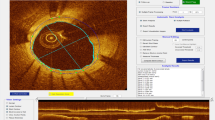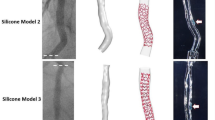Abstract
The implantation of intracoronary stents is currently the standard approach for the treatment of coronary atherosclerotic disease. The widespread adoption of this technology has boosted an intensive research activity in this domain, with continuous improvements in the design of these devices, aiming at reducing problems of restenosis (re-narrowing of the stented segment) and thrombosis (sudden occlusion due to thrombus formation). Recently, a new, light-based intracoronary imaging modality, optical coherence tomography (OCT), was developed and introduced into clinical practice. Due to its very high axial resolution (10–15 μm), it allows for in vivo evaluation of both stent strut apposition and neointima coverage (a marker of healing of the treated segment). As such, it provides valuable information on proper stent deployment, on the behaviour of different stent types in-vivo and on the effect of new types of stents (e.g. drug-eluting stents) on vessel wall healing. However, the major drawback of the current OCT methodology is that analysis of these images requires a tremendous amount of—currently manual—post-processing. In this manuscript, an algorithm is presented that allows for fully automated analysis of stent strut apposition and coverage in coronary arteries. The vessel lumen and stent struts are automatically detected and segmented through analysis of the intensity profiles of the A-lines. From these data, apposition and coverage can then be measured automatically. The algorithm was validated using manual assessments by two experienced operators as a reference. High Pearson’s correlation coefficients were found (R = 0.96–0.97) between the automated and manual measurements while Bland–Altman analysis showed no significant bias with good limits of agreement. As such, it was shown that the presented algorithm provides a robust and fast tool to automatically estimate apposition and coverage of stent struts in in-vivo OCT pullbacks. This will be important for the integration of this technology in clinical routine and for the analysis of datasets of larger clinical trials.









Similar content being viewed by others
References
Bezerra HG, Costa MA, Guagliumi G, Rollins AM, Simon D (2009) Intracoronary optical coherence tomography: a comprehensive review. JACC Cardiovasc Interv 2:1035–1046
Prati F, Regard E, Mintz GS, Arbustini E, Di Mario C, Jang I, Akasaka T, Costa M, Guagliumi G, Grube E, Ozaki Y, Pinto F, Serruys PW J (2009) Expert review document on methodology, terminology, and clinical application of optical coherence tomography: physical principles, methodology of image acquisition, and clinical application for assessment of coronary arteries and atherosclerosis. Eur Heart J 31:401–415
Terashima M, Rathore S, Suzuki Y, Nakayama Y, Kaneda H, Nasu H, Habara M, Katoh O, Suzuki T (2009) Accuracy and reproducibility of stent-strut thickness determined by optical coherence tomography. J Invasive Cardiol 21:602–605
Tearney G J et al (2008) Three dimensional coronary artery microscopy by intra coronary optical coherence tomography. JACC Cardiovasc Imaging 1:752–761
Kotani J, Awata M, Nanto S, Uematsu M, Oshima F, Minamiguchi H, Mintz G S, Nagata S (2006) Incomplete neointima coverage of Sirolimus-eluting stents angioscopic findings. JACC Cardiovasc Interv 47:2108–2111
Hong M et al (2004) Incidence, mechanism, predictors and long-term prognosis of late stent malapposition after bare-metal stent implantation. Circulation 109:881–886
Finn AV, Joner M, Nakazawa G, Kolodgie F, Newell J, John MC, Herman KG, Virmani R (2007) Pathological correlates of late drug-eluting stent thrombosis: strut coverage as a marker of endothelialization. Circulation 115:435–441
G Guagliumi and V Sirbu (2008) Optical coherence tomography: high resolution intravascular imaging to evaluate vascular healing after coronary stenting. Catheter Cardiovasc Interv 72:237–247
Murata A et al (2010) Accuracy of optical coherence tomography in the evaluation of neointimal coverage after stent implantation. JACC Cardiovasc Imaging 3:76–84
Unal G, Gurmeric S and Carlier S G (2009) Stent implant follow-up in intravascular optical coherence tomography images. Int J Cardiovasc Imaging. 6:1569–1573
Sawada T et al (2009) Factors that influence measurement and accurate evaluation of stent apposition by optical coherence tomography. Cardiovasc interv 73:1841–1847
Paul Dierckx (1993) Curve and surface fitting with splines, monograph on numerical analysis. Oxford Science Publication, Oxford, pp 75–118
WK Pratt (2001) Digital image processing: PIKS inside, 3rd edn. Wiley Inc, Hoboken, New Jersey, pp 393–398, 647–672
Conflict of interest
None.
Author information
Authors and Affiliations
Corresponding author
Rights and permissions
About this article
Cite this article
Ughi, G.J., Adriaenssens, T., Onsea, K. et al. Automatic segmentation of in-vivo intra-coronary optical coherence tomography images to assess stent strut apposition and coverage. Int J Cardiovasc Imaging 28, 229–241 (2012). https://doi.org/10.1007/s10554-011-9824-3
Received:
Accepted:
Published:
Issue Date:
DOI: https://doi.org/10.1007/s10554-011-9824-3




